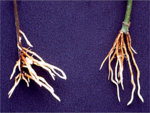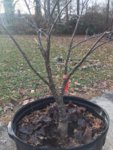William N. Valavanis
Chumono
I propagate, grow and train Rough Bark Japanese Maples, Acer palmatum ‘Arakawa.’
Over the past 50 years or so I’ve seen, grown and evaluated dozens of maples with interesting bark. The cultivar ‘Nishiki Gawa’ is the same as ‘Nishiki Issai’.
In the horticultural world the Japanese word “Issai” means “developing from the first year” and is used to designate plants which develop a desirable characteristic early on. Early flowering and fruiting cultivars often have the word issai attached to the name.
The Japanese word “Nishiki” means brocade or most beautiful. However in the horticultural world Nishiki is used to describe plants with corky bark OR variegated foliage. Nishiki is commonly used to describe Japanese black pine, Japanese five-needle pine and Japanese red pines with corky bark, not rough bark.
The Japanese word “Arakawa” means rough bark and is used for many different species.
The Japanese word “Ibo Kan” means wart bark and is used for pines and maples which have dark brown bark in fine sections.
Many years ago I compiled a handout describing different bark characteristics for pines, which can also be applied to other species as well. I was able to find an old copy and its attached.
Also attached is a page from my old catalog issued in 1979. Here you can clearly see that the cultivar Nishiki Gawa (Nishiki Issai) is NOT the same as Arakawa. In the handout you can see the different bark characteristics and Nishiki is not the same as Arakawa. I believe that perhaps the Nishiki Japanese maples in the United States commercial nurseries are actually Arakawa. Just check the bark….
I used to grow Nishiki Issai, but discovered, although it has interesting bark, it is extremely difficult to simply grow and only way to propagate it is grafting.
The Rough Bark Japanese Maple Arakawa is very easy to grow and train for bonsai. Semi softwood cuttings can be rooted during the summer and it airlayers quickly in about 4-6 weeks during the summer.
Check out this link to see my blog post on Rough Bark Japanese Maples and how we are now growing them from select seedlings.
https://valavanisbonsaiblog.com/2018/05/17/rough-bark-japanese-maples/
Drastic pruning is the correct term to use when cutting off large trunks or branches, NOT “trunk chop.” I have discovered that specimens of Rough Bark Japanese Maples with the dark brown bark will not produce adventitious buds and branches like other old maples. However, if the bark is still green, new shoots will grow from old wood.
The way to get new branches on old Rough Bark Japanese Maples easily is to simply thread or approach graft. Since my Classical Bonsai Art book is now out of print and copies have been sold for $500, I’m also attaching the two pages on Rough Bark Japanese Maples which illustrates inarch/thread grafting techniques.
Not to confuse anyone but there are Arakawa and Ibo Kan cultivars of Trident maples also.
Still, I believe the finest Japanese maple for bonsai training is the species, Acer palmatum. It has lovely bark which presents a fine quiet feeling for the delicate Japanese maple. Other “rough” or textured bark cultivars are interesting and add impact to the appearance, but they lose the delicate feeling of a Japanese maple. The same goes for the many dwarf cultivars such as Kashima, Kiyo Hime and Koto Hime.
Amen.
Boy, preparing this post took me 3 hours, plus over 50 years of successes and failures trying to study bonsai, but I want to get the information out so others can enjoy bonsai as much as I have.
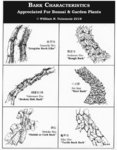

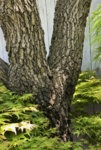
Acer palmatum 'Arakawa' growing in my garden from a cutting I rooted over 40 years ago. Even surface roots 5 feet from the trunk have rough bark.
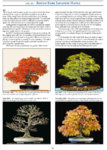
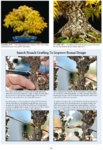

Be sure to visit my blog page if you are interested in Rough Bark Japanese Maples:
https://valavanisbonsaiblog.com/2018/05/17/rough-bark-japanese-maples/
Over the past 50 years or so I’ve seen, grown and evaluated dozens of maples with interesting bark. The cultivar ‘Nishiki Gawa’ is the same as ‘Nishiki Issai’.
In the horticultural world the Japanese word “Issai” means “developing from the first year” and is used to designate plants which develop a desirable characteristic early on. Early flowering and fruiting cultivars often have the word issai attached to the name.
The Japanese word “Nishiki” means brocade or most beautiful. However in the horticultural world Nishiki is used to describe plants with corky bark OR variegated foliage. Nishiki is commonly used to describe Japanese black pine, Japanese five-needle pine and Japanese red pines with corky bark, not rough bark.
The Japanese word “Arakawa” means rough bark and is used for many different species.
The Japanese word “Ibo Kan” means wart bark and is used for pines and maples which have dark brown bark in fine sections.
Many years ago I compiled a handout describing different bark characteristics for pines, which can also be applied to other species as well. I was able to find an old copy and its attached.
Also attached is a page from my old catalog issued in 1979. Here you can clearly see that the cultivar Nishiki Gawa (Nishiki Issai) is NOT the same as Arakawa. In the handout you can see the different bark characteristics and Nishiki is not the same as Arakawa. I believe that perhaps the Nishiki Japanese maples in the United States commercial nurseries are actually Arakawa. Just check the bark….
I used to grow Nishiki Issai, but discovered, although it has interesting bark, it is extremely difficult to simply grow and only way to propagate it is grafting.
The Rough Bark Japanese Maple Arakawa is very easy to grow and train for bonsai. Semi softwood cuttings can be rooted during the summer and it airlayers quickly in about 4-6 weeks during the summer.
Check out this link to see my blog post on Rough Bark Japanese Maples and how we are now growing them from select seedlings.
https://valavanisbonsaiblog.com/2018/05/17/rough-bark-japanese-maples/
Drastic pruning is the correct term to use when cutting off large trunks or branches, NOT “trunk chop.” I have discovered that specimens of Rough Bark Japanese Maples with the dark brown bark will not produce adventitious buds and branches like other old maples. However, if the bark is still green, new shoots will grow from old wood.
The way to get new branches on old Rough Bark Japanese Maples easily is to simply thread or approach graft. Since my Classical Bonsai Art book is now out of print and copies have been sold for $500, I’m also attaching the two pages on Rough Bark Japanese Maples which illustrates inarch/thread grafting techniques.
Not to confuse anyone but there are Arakawa and Ibo Kan cultivars of Trident maples also.
Still, I believe the finest Japanese maple for bonsai training is the species, Acer palmatum. It has lovely bark which presents a fine quiet feeling for the delicate Japanese maple. Other “rough” or textured bark cultivars are interesting and add impact to the appearance, but they lose the delicate feeling of a Japanese maple. The same goes for the many dwarf cultivars such as Kashima, Kiyo Hime and Koto Hime.
Amen.
Boy, preparing this post took me 3 hours, plus over 50 years of successes and failures trying to study bonsai, but I want to get the information out so others can enjoy bonsai as much as I have.



Acer palmatum 'Arakawa' growing in my garden from a cutting I rooted over 40 years ago. Even surface roots 5 feet from the trunk have rough bark.



Be sure to visit my blog page if you are interested in Rough Bark Japanese Maples:
https://valavanisbonsaiblog.com/2018/05/17/rough-bark-japanese-maples/


